Abstract
We describe an approach to the synthesis of peptides from segments bearing no protecting groups through an orthogonal coupling method to capture the acyl segment as a thioester that then undergoes an intramolecular acyl transfer to the amine component with formation of a peptide bond. Two orthogonal coupling methods to give the covalent ester intermediate were achieved by either a thiol-thioester exchange mediated by a trialkylphosphine and an alkylthiol or a thioesterification by C alpha-thiocarboxylic acid reacting with a beta-bromo amino acid. With this approach, unprotected segments ranging from 4 to 37 residues were coupled to aqueous solution to give free peptides up to 54 residues long with high efficiency.
Full text
PDF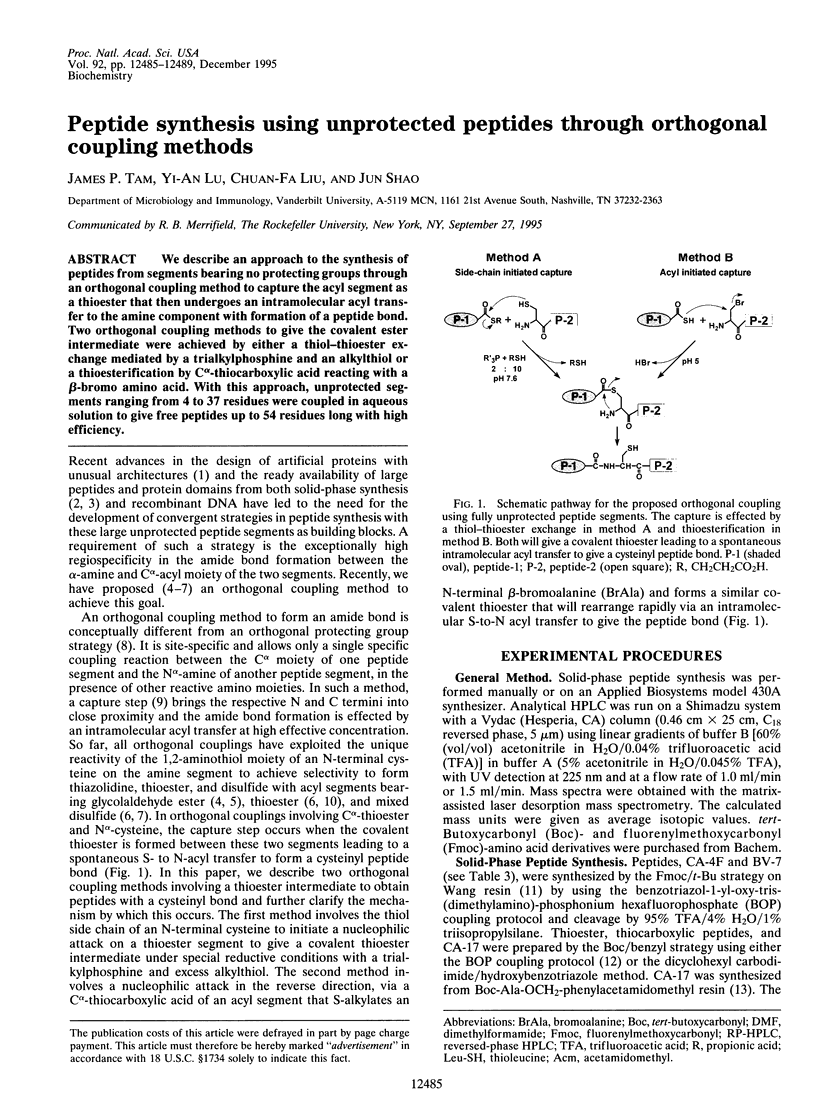
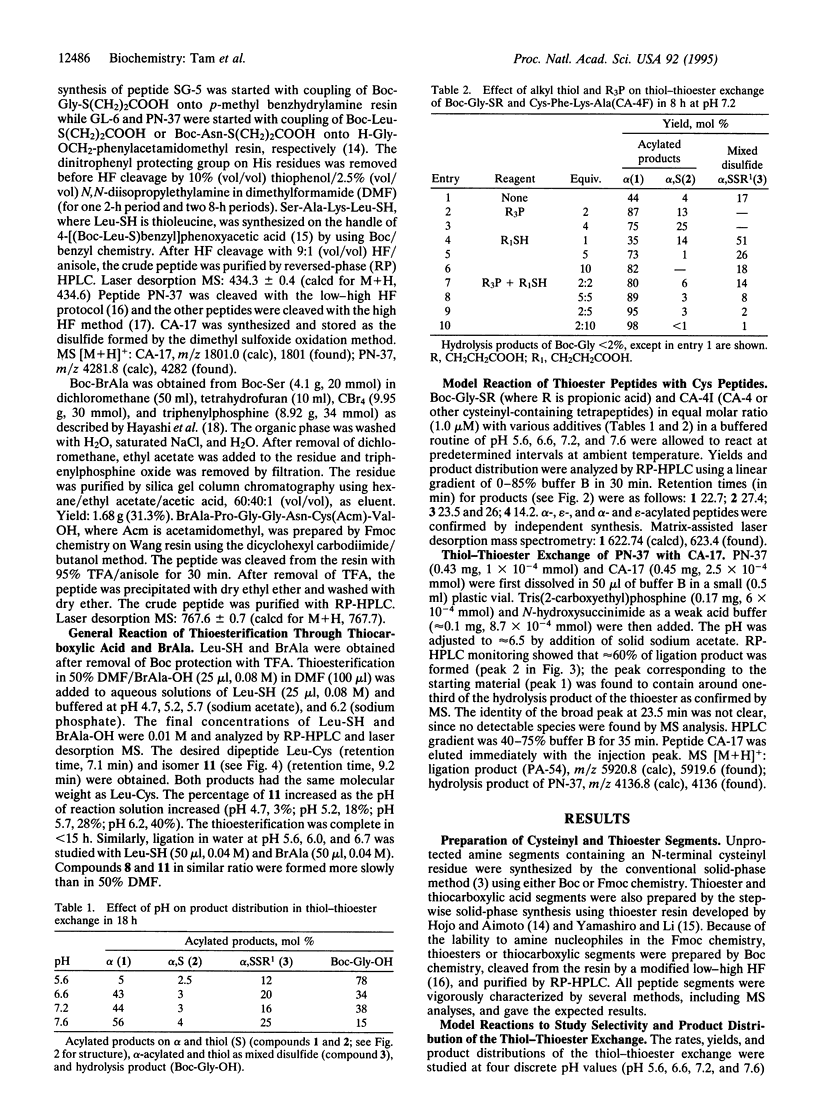
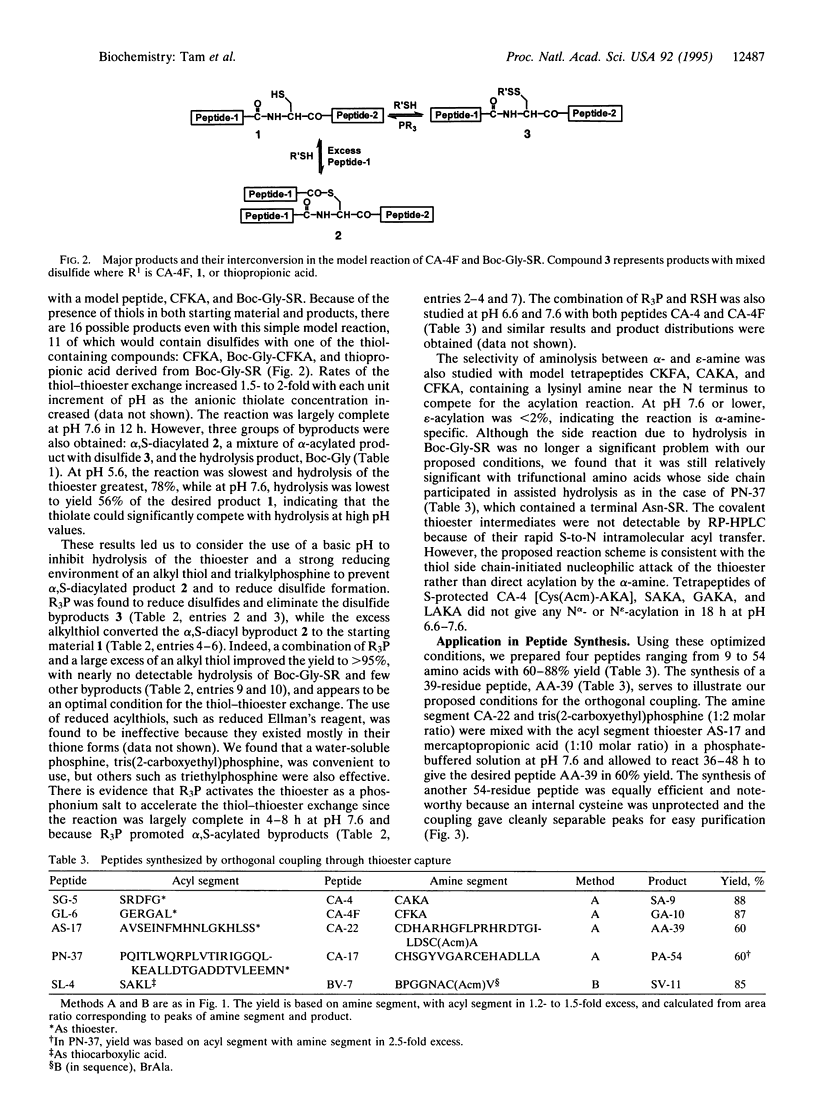
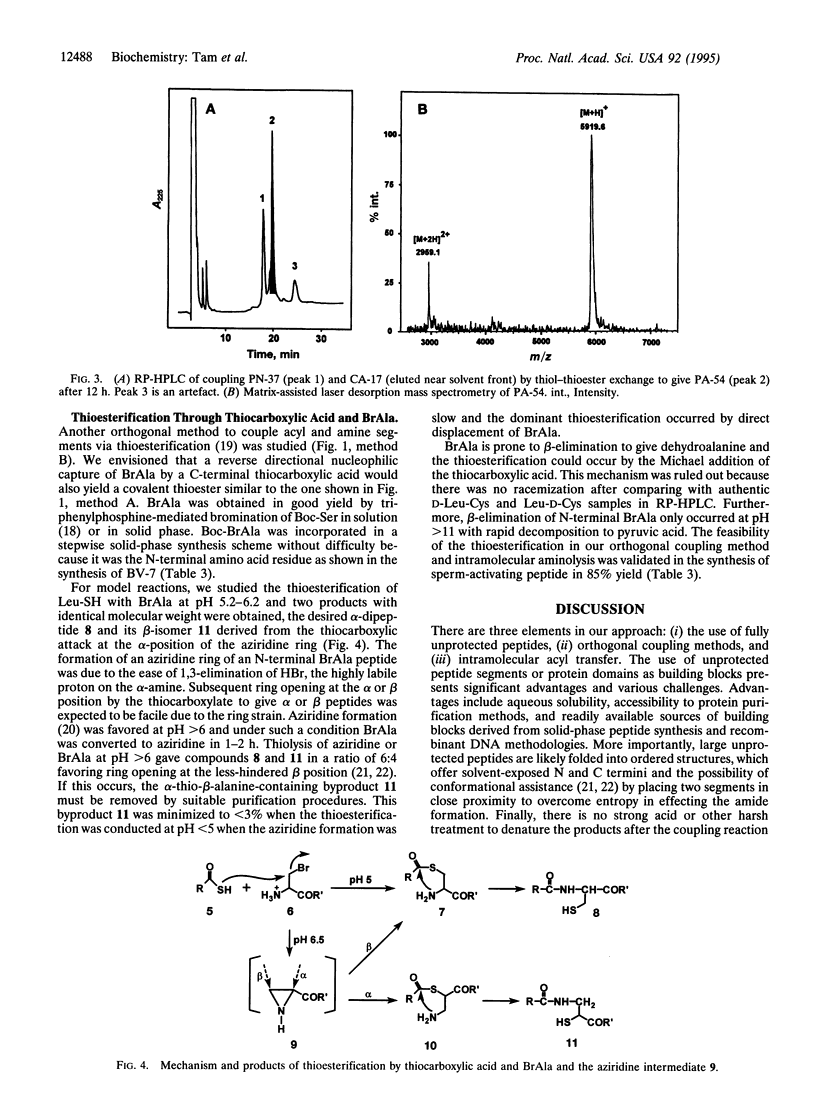
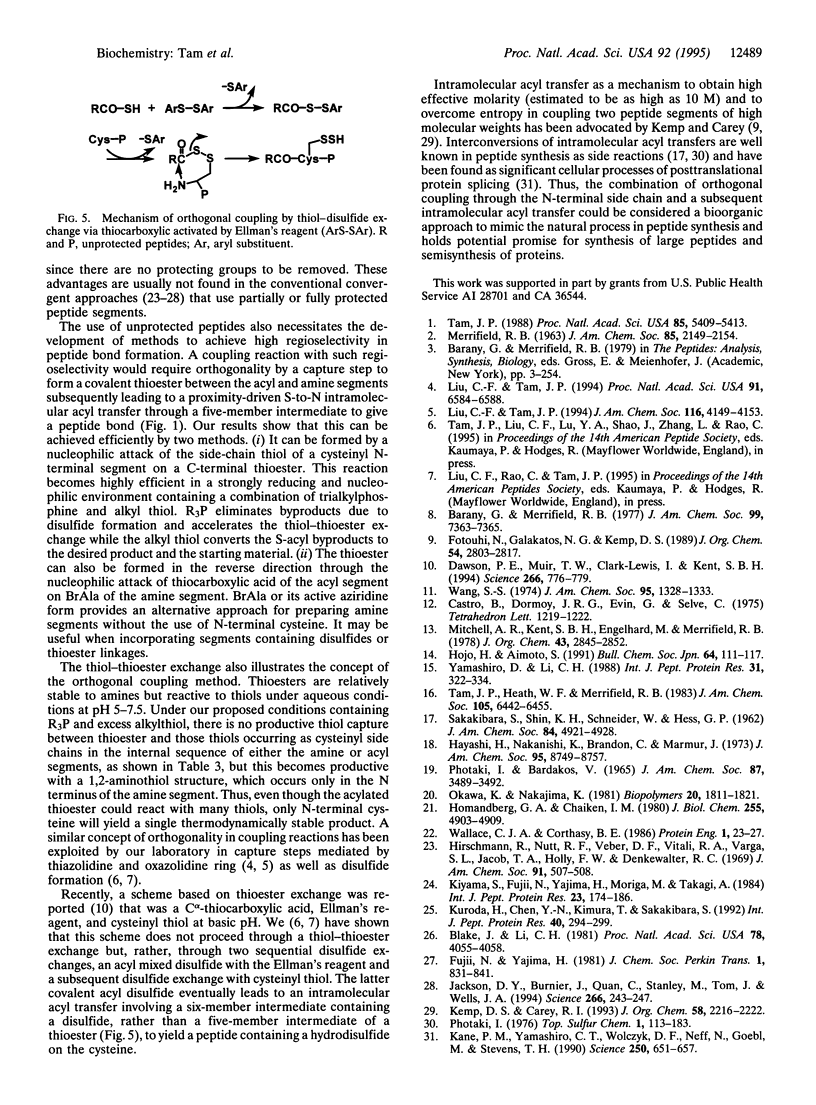
Images in this article
Selected References
These references are in PubMed. This may not be the complete list of references from this article.
- Barany G., Merrifield R. B. A new amino protecting group removable by reduction. Chemistry of the dithiasuccinoyl (Dts) function. J Am Chem Soc. 1977 Oct 26;99(22):7363–7365. doi: 10.1021/ja00464a050. [DOI] [PubMed] [Google Scholar]
- Blake J., Li C. H. New segment-coupling method for peptide synthesis in aqueous solution: application to synthesis of human [Gly17]-beta-endorphin. Proc Natl Acad Sci U S A. 1981 Jul;78(7):4055–4058. doi: 10.1073/pnas.78.7.4055. [DOI] [PMC free article] [PubMed] [Google Scholar]
- Dawson P. E., Muir T. W., Clark-Lewis I., Kent S. B. Synthesis of proteins by native chemical ligation. Science. 1994 Nov 4;266(5186):776–779. doi: 10.1126/science.7973629. [DOI] [PubMed] [Google Scholar]
- Hayashi H., Nakanishi K., Brandon C., Marmur J. Structure and synthesis of dihydroxypentyluracil from bacteriophage SP-15 deoxyribonucleic acid. J Am Chem Soc. 1973 Dec 26;95(26):8749–8757. doi: 10.1021/ja00807a041. [DOI] [PubMed] [Google Scholar]
- Hirschmann R., Nutt R. F., Veber D. F., Vitali R. A., Varga S. L., Jacob T. A., Holly F. W., Denkewalter R. G. Studies on the total synthesis of an enzyme. V. The preparation of enzymatically active material. J Am Chem Soc. 1969 Jan 15;91(2):507–508. doi: 10.1021/ja01030a055. [DOI] [PubMed] [Google Scholar]
- Homandberg G. A., Chaiken I. M. Trypsin-catalyzed conversion of staphylococcal nuclease-T fragment complexes to covalent forms. J Biol Chem. 1980 May 25;255(10):4903–4909. [PubMed] [Google Scholar]
- Jackson D. Y., Burnier J., Quan C., Stanley M., Tom J., Wells J. A. A designed peptide ligase for total synthesis of ribonuclease A with unnatural catalytic residues. Science. 1994 Oct 14;266(5183):243–247. doi: 10.1126/science.7939659. [DOI] [PubMed] [Google Scholar]
- Kane P. M., Yamashiro C. T., Wolczyk D. F., Neff N., Goebl M., Stevens T. H. Protein splicing converts the yeast TFP1 gene product to the 69-kD subunit of the vacuolar H(+)-adenosine triphosphatase. Science. 1990 Nov 2;250(4981):651–657. doi: 10.1126/science.2146742. [DOI] [PubMed] [Google Scholar]
- Kiyama S., Fujii N., Yajima H., Moriga M., Takagi A. Studies on peptides. CXIII. Synthesis of the heptacosapeptide amide corresponding to the entire amino acid sequence of chicken secretin. Int J Pept Protein Res. 1984 Feb;23(2):174–186. [PubMed] [Google Scholar]
- Kuroda H., Chen Y. N., Kimura T., Sakakibara S. Powerful solvent systems useful for synthesis of sparingly-soluble peptides in solution. Int J Pept Protein Res. 1992 Sep-Oct;40(3-4):294–299. doi: 10.1111/j.1399-3011.1992.tb00304.x. [DOI] [PubMed] [Google Scholar]
- Liu C. F., Tam J. P. Peptide segment ligation strategy without use of protecting groups. Proc Natl Acad Sci U S A. 1994 Jul 5;91(14):6584–6588. doi: 10.1073/pnas.91.14.6584. [DOI] [PMC free article] [PubMed] [Google Scholar]
- PHOTAKI I., BARDAKOS V. TRANSFORMATION OF L-SERINE PEPTIDES TO L-CYSTEINE PEPTIDES. J Am Chem Soc. 1965 Aug 5;87:3489–3492. doi: 10.1021/ja01093a037. [DOI] [PubMed] [Google Scholar]
- Tam J. P. Synthetic peptide vaccine design: synthesis and properties of a high-density multiple antigenic peptide system. Proc Natl Acad Sci U S A. 1988 Aug;85(15):5409–5413. doi: 10.1073/pnas.85.15.5409. [DOI] [PMC free article] [PubMed] [Google Scholar]
- Wallace C. J., Corthésy B. E. Protein engineering of cytochrome c by semisynthesis: substitutions at glutamic acid 66. Protein Eng. 1986 Oct-Nov;1(1):23–27. [PubMed] [Google Scholar]
- Wang S. S. p-alkoxybenzyl alcohol resin and p-alkoxybenzyloxycarbonylhydrazide resin for solid phase synthesis of protected peptide fragments. J Am Chem Soc. 1973 Feb 21;95(4):1328–1333. doi: 10.1021/ja00785a602. [DOI] [PubMed] [Google Scholar]
- Yamashiro D., Li C. H. New segment synthesis of alpha-inhibin-92 by the acyl disulfide method. Int J Pept Protein Res. 1988 Mar;31(3):322–334. doi: 10.1111/j.1399-3011.1988.tb00040.x. [DOI] [PubMed] [Google Scholar]



